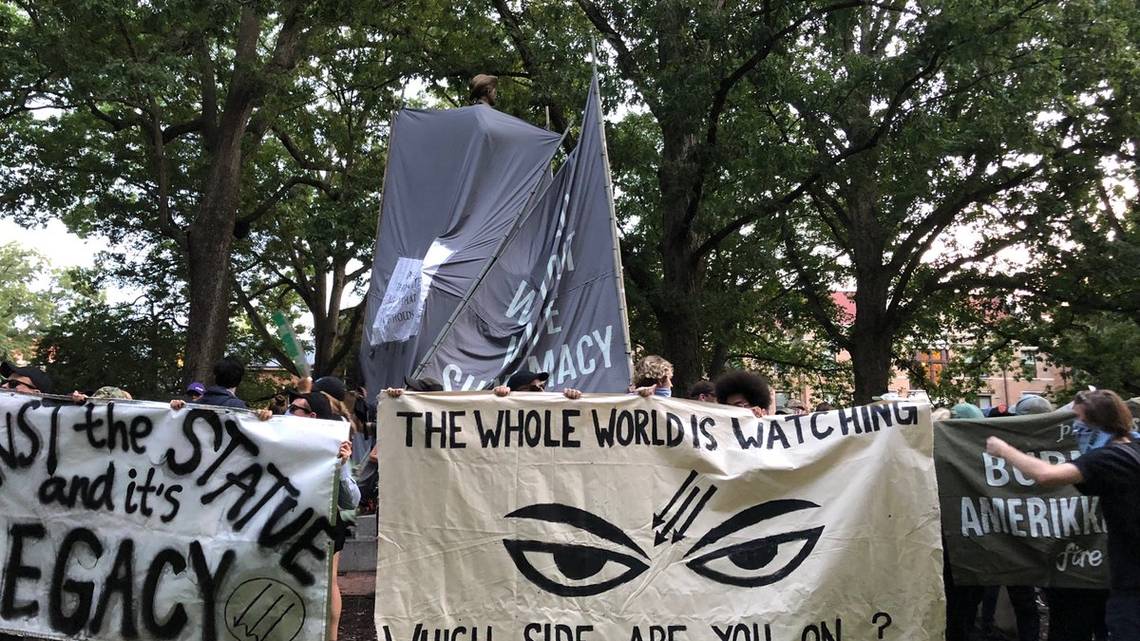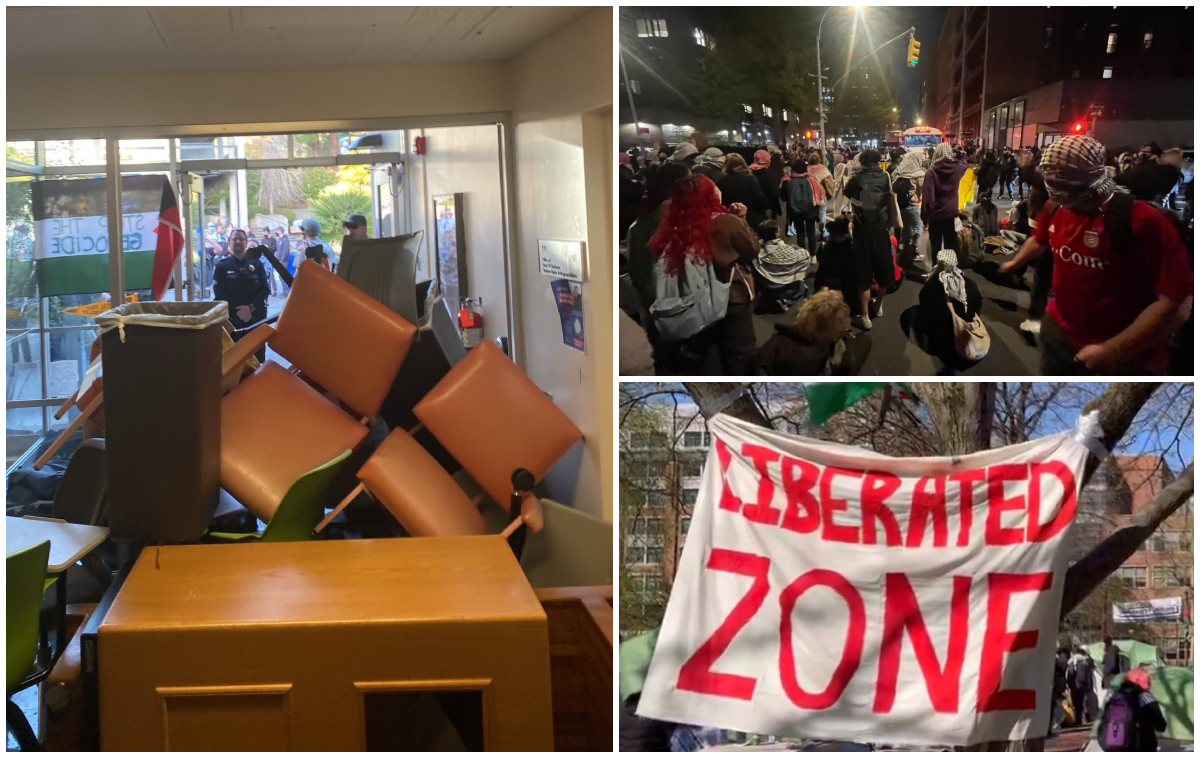Filed under: Analysis, Anarchist Movement, Anti-fascist, Featured, Police, Southeast, White Supremacy

A report back and an analysis of the anti-Silent Sam actions that toppled the statue in North Carolina.
Last night, 300 people tore down the Silent Sam Confederate statue on UNC-Chapel Hill campus.
The evening began outside the Chapel Hill post office at 7 p.m. A crowd of a couple hundred gathered to listen to speeches by black UNC students and their supporters including Maya Little, who faces criminal charges for dousing the statue in red paint mixed with her own blood in April. The speeches were as beautiful as they were energizing, and concluded with two black students pledging to wear nooses around their necks until the statue was removed and a rousing call from Maya for solidarity with protesters who had chosen to wear masks. Many in the crowd sported blue and white bandanas in the UNC Chapel Hill school colors with the antifascist Iron Front (three arrows) across a silhouette of Silent Sam. Four neo-Confederate counter-protesters stood two blocks down the street. Ten to twelve cops waited for us on the green.
“Suddenly, the front of the banner box fell away and a rope materialized around Silent Sam’s neck. Over 100 people grabbed the rope and began pulling, pulling, pulling until, all of a sudden — Sam was down! The crowd roared.”
Four twenty-foot high banners zip-tied to bamboo poles formed the backdrop for the speak-out. Following the last speech, a rousing call for solidarity with the angry folks wearing masks may be feeling from Maya, folks rolled up the banners and began a peaceful but energetic march across the street. As soon as the crowd crossed into the green, however, four to five cops waded into the crowd, demanding that people de-mask. After marchers refused to comply with their demands, the police attacked the crowd, attempting to arrest two to three masked protesters. The crowd reacted immediately and a brawl broke out. Several smoke bombs were thrown and all but one person was successfully wrestled away from the police. This led to a police retreat.
The brief brawl distracted the police and allowed those carrying the twenty-foot banners to move swiftly to the center of the green and remount them on all sides of the monument, covering it completely. Several groups of people worked diligently to zip tie the bamboo poles to one another while another group staked the two-story cloth box to the ground with lines attached to the banners. Having defeated the police, the crowd regrouped and formed multiple human chains around the monument.
For about an hour people chanted, gave additional speeches, and played music from a big bluetooth speaker at the foot of the statue. Songs included Guillotine by The Coup, 16 Shots by Vic Mensa, and Renegades of Funk by Rage Against the Machine. The police eventually regrouped as well, and stood at a safe distance with four to five neo-Confederates who had followed the march across the street. Shouting matches and taunts ensued.
Once the banner-box was fully secure, around 250 of the 300-person crowd marched off the green, took the entire street with banners and human chains, and proceeded down the main commercial strip to a nearby intersection (Franklin and Columbia). The combination of joy, anger, and confidence was infectious; more than a few college students joined the march, and over a dozen bystanders ran off the sidewalk to give high-fives and thank the protesters. The police kept their distance, and the crowd managed to blockade the intersection without difficulty.
Several of the BLM organizers kept the energy up with “fuck-12” chants, but just as a second round of speak-outs was about to begin, word came that the police were trying to retake control the statue from those that remained. We immediately marched back at top speed, stopping only to briefly de-mask and then eject two neo-Confederates who tried to enter into the crowd but were quickly repelled with fists and water bottles. Once back at the statue we saw that the police had encircled our banner box. Once again, the crowd responded swiftly and with impressive discipline and coordination: the march dispersed into an even larger circle, besieged the police with banners and human chains, and began shouting down the police, whose numbers had swelled slightly but not to more than twenty. The weather quickly turned to water bottles and rocks and the police beat a hasty retreat, allowing the crowd to retake the monument. The neo-Confederates who had been following us simply looked on, powerless and irrelevant.
“We had an enormously different experience of what is often called “identity politics” — black experience was at the center of the action, but no one asserted the inaccessibility of this experience to non-black people as a reason to avoid or reduce the level of conflict with police.”
Suddenly, the front of the banner box fell away and a rope materialized around Silent Sam’s neck. Over 100 people grabbed the rope and began pulling, pulling, pulling until, all of a sudden — Sam was down! The crowd roared. What had initially appeared to be a symbolic act of free speech, concealing the statue with our own anti-racist views, turned out to be just the first phase of a direct action to tear down another Confederate monument. One year after Durham, we had done it again.
The jubilation from the crowd was electric. Smoke bombs went off in every direction. Former strangers cried and hugged each other. The crowd continued cheering, chanting, and throwing dirt onto the statue for well over an hour. The neo-Confederates wilted completely and several of them left. The police, having just suffered their third and most embarrassing defeat of the night, stood back and watched us dance. A lone neo-Confederate who kept trying to “just make himself heard” lost his hat and was chased off the green. It began to rain, but no one left.
What did we learn from the evening? We will need a minute to organize all the joyous thoughts, but here are a few lessons we certainly learned:
- We had an enormously different experience of what is often called “identity politics” — black experience was at the center of the action (in that it was centered on Maya Little and other black students, and Black Lives Matter, and other activists of color led the marches and chants), but no one asserted the inaccessibility of this experience to non-black people as a reason to avoid or reduce the level of conflict with police. This was in stark contrast to experiences that both black and non-black militants and insurrectionaries have had of black leftists in other cities.
- Even if something appears to be a leftist or de-escalatory gesture, it is extremely important not to let this demoralize you. Stay — you don’t know what’s going to happen next, especially when the event is well-framed. Similarly, it is sometimes important to attend and listen what you might expect to be “boring” experiences like speak-outs. The spirit and content of the speeches helped set a militant tone that intensified the crowd’s determination and expanded its capacity for tactical imagination.
- Smoke bombs both disorient enemies and energize friends, and are nowhere near as scary as other sorts of fireworks.
- Because the masks were symbolic expressions of UNC student identity (blue, and also with the antifascist “Iron Front” across the silhouette of Silent Sam), removing them was more scandalous, both for police and for white supremacists.





